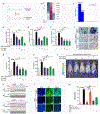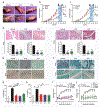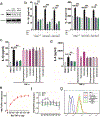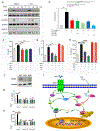Fexofenadine inhibits TNF signaling through targeting to cytosolic phospholipase A2 and is therapeutic against inflammatory arthritis
- PMID: 31302596
- PMCID: PMC8157820
- DOI: 10.1136/annrheumdis-2019-215543
Fexofenadine inhibits TNF signaling through targeting to cytosolic phospholipase A2 and is therapeutic against inflammatory arthritis
Abstract
Objective: Tumour necrosis factor alpha (TNF-α) signalling plays a central role in the pathogenesis of various autoimmune diseases, particularly inflammatory arthritis. This study aimed to repurpose clinically approved drugs as potential inhibitors of TNF-α signalling in treatment of inflammatory arthritis.
Methods: In vitro and in vivo screening of an Food and Drug Administration (FDA)-approved drug library; in vitro and in vivo assays for examining the blockade of TNF actions by fexofenadine: assays for defining the anti-inflammatory activity of fexofenadine using TNF-α transgenic (TNF-tg) mice and collagen-induced arthritis in DBA/1 mice. Identification and characterisation of the binding of fexofenadine to cytosolic phospholipase A2 (cPLA2) using drug affinity responsive target stability assay, proteomics, cellular thermal shift assay, information field dynamics and molecular dynamics; various assays for examining fexofenadine inhibition of cPLA2 as well as the dependence of fexofenadine's anti-TNF activity on cPLA2.
Results: Serial screenings of a library composed of FDA-approved drugs led to the identification of fexofenadine as an inhibitor of TNF-α signalling. Fexofenadine potently inhibited TNF/nuclear factor kappa-light-chain-enhancer of activated B cells (NF-ĸB) signalling in vitro and in vivo, and ameliorated disease symptoms in inflammatory arthritis models. cPLA2 was isolated as a novel target of fexofenadine. Fexofenadine blocked TNF-stimulated cPLA2 activity and arachidonic acid production through binding to catalytic domain 2 of cPLA2 and inhibition of its phosphorylation on Ser-505. Further, deletion of cPLA2 abolished fexofenadine's anti-TNF activity.
Conclusion: Collectively, these findings not only provide new insights into the understanding of fexofenadine action and underlying mechanisms but also provide new therapeutic interventions for various TNF-α and cPLA2-associated pathologies and conditions, particularly inflammatory rheumatic diseases.
Keywords: TNF-α; cPLA2; fexofenadine; inflammation; inflammatory arthritis.
© Author(s) (or their employer(s)) 2019. No commercial re-use. See rights and permissions. Published by BMJ.
Conflict of interest statement
Competing interests: None declared.
Figures






References
-
- Barturen G, Beretta L, Cervera R, et al. Moving towards a molecular taxonomy of autoimmune rheumatic diseases. Nature reviews Rheumatology 2018, 14(2):75–93. - PubMed
-
- Brenner D, Blaser H, Mak TW. Regulation of tumour necrosis factor signalling: live or let die. Nat Rev Immunol 2015, 15(6):362–374. - PubMed
Publication types
MeSH terms
Substances
Grants and funding
LinkOut - more resources
Full Text Sources
Other Literature Sources
Miscellaneous

